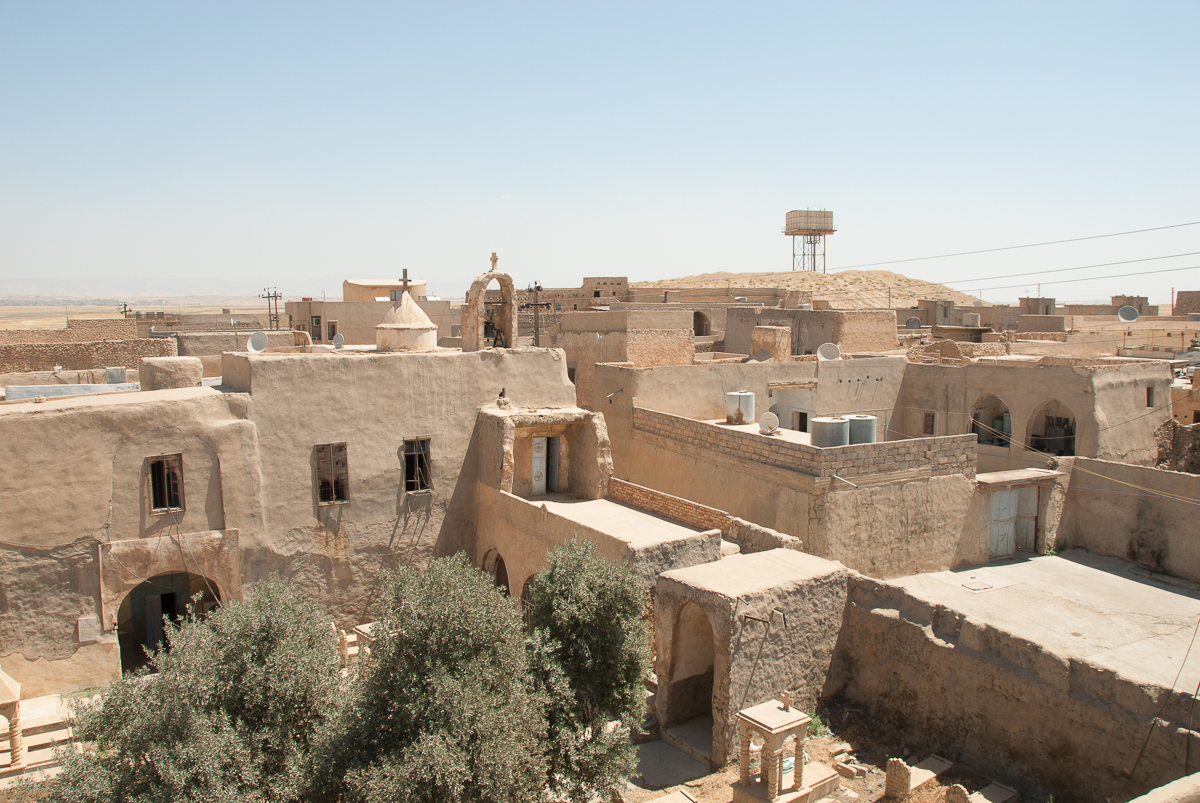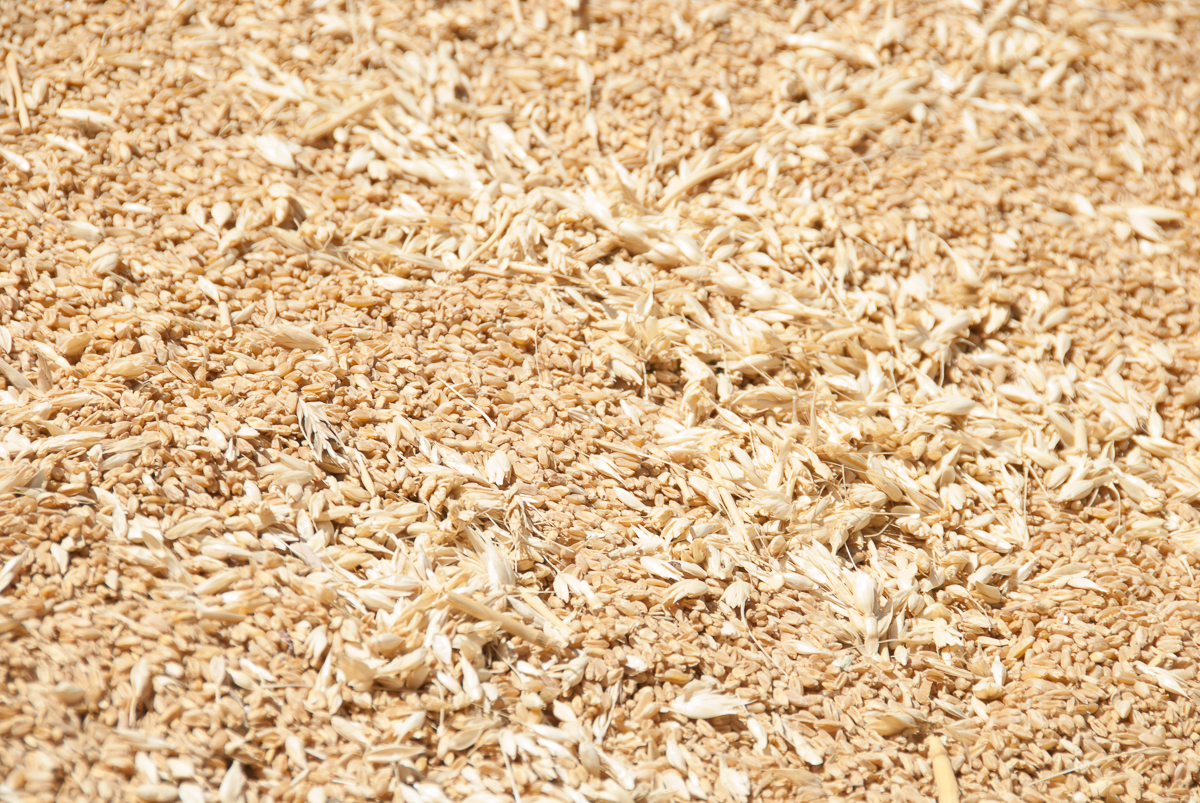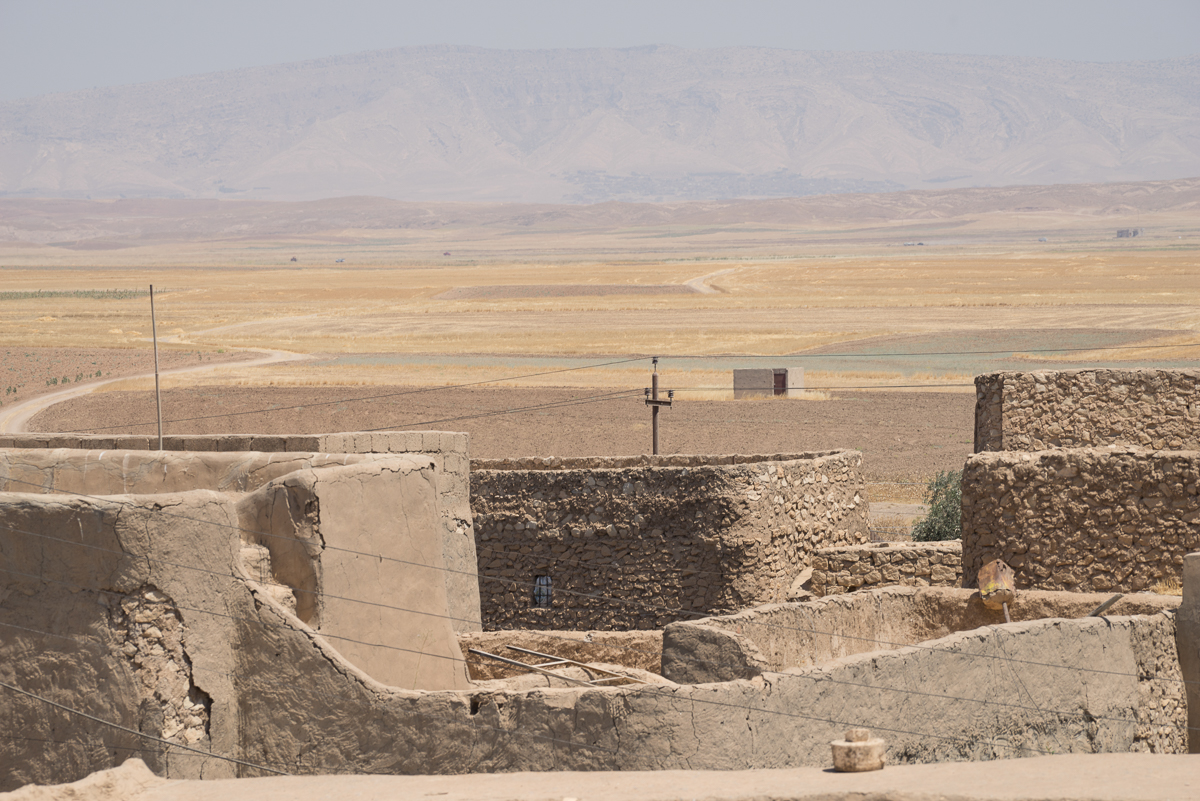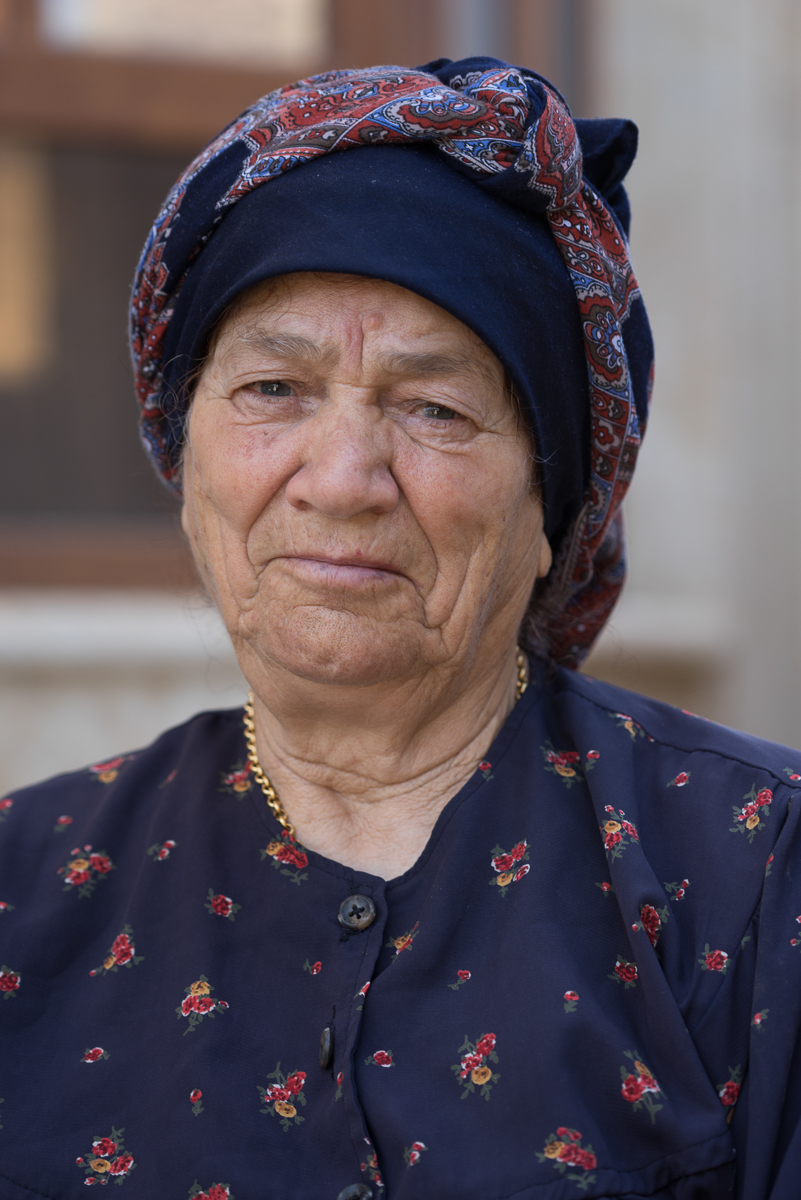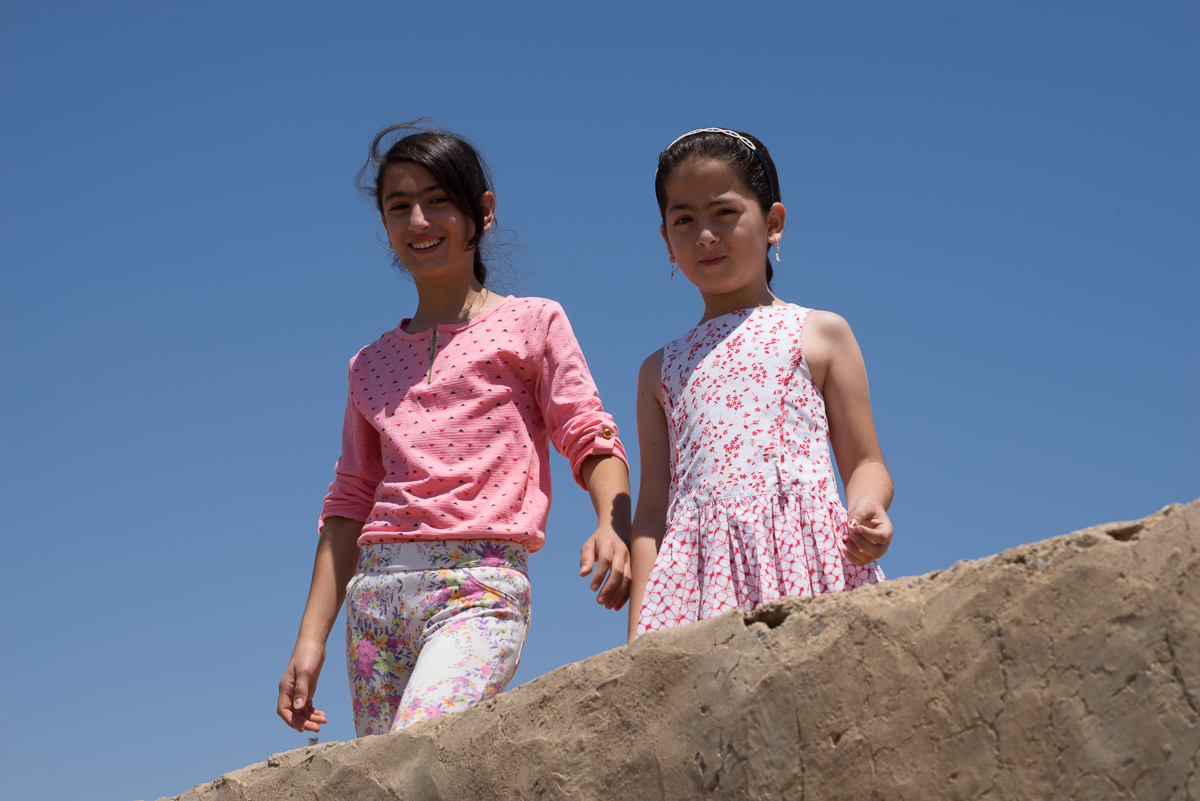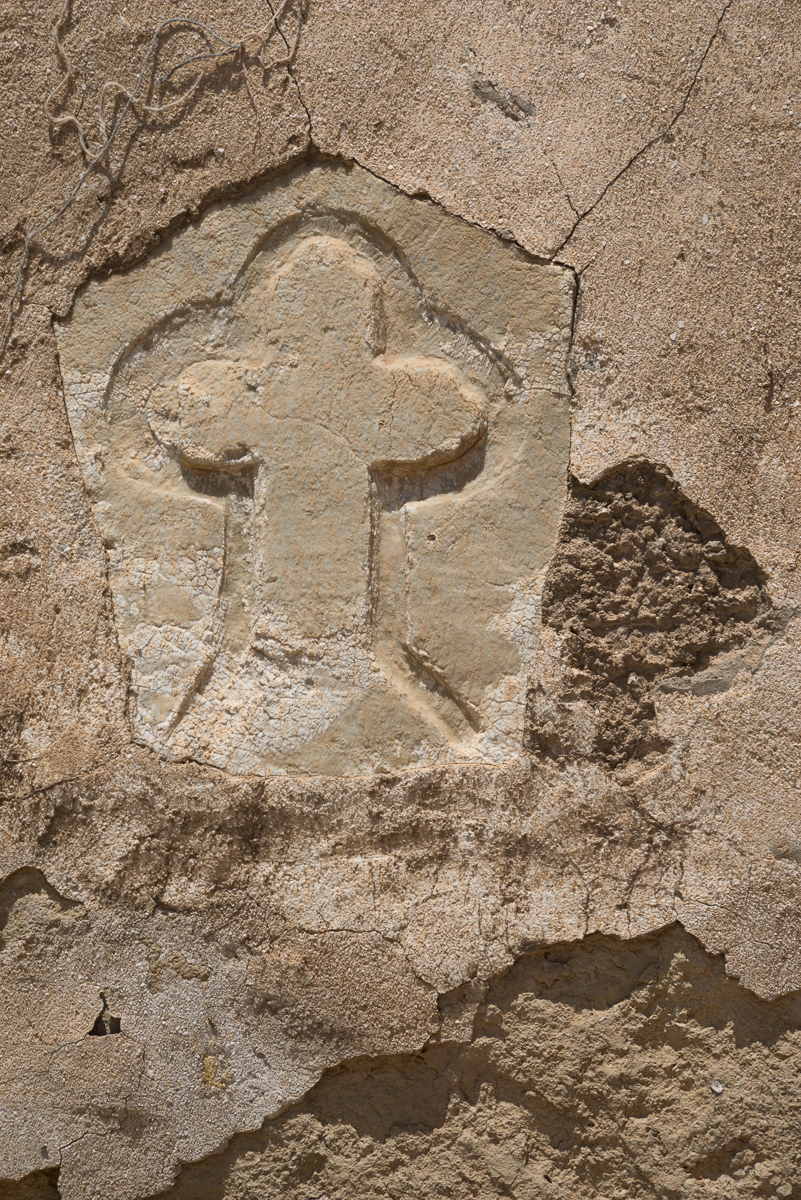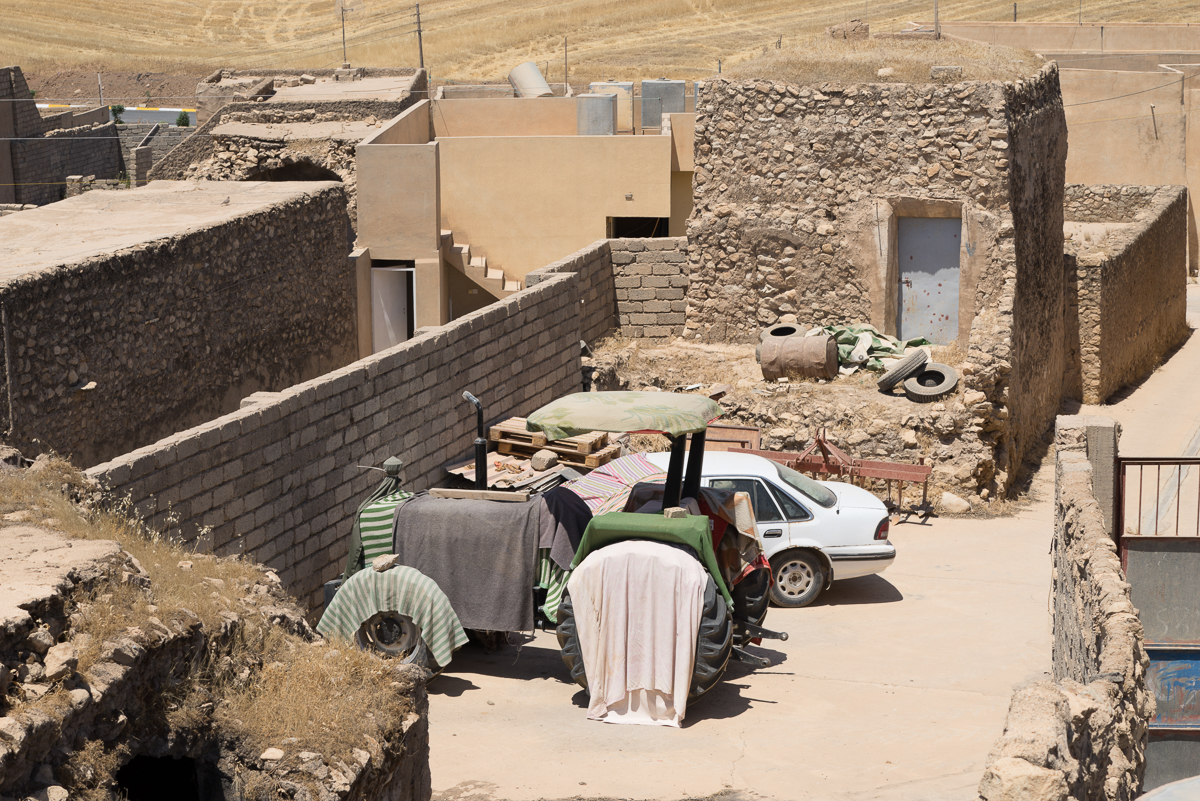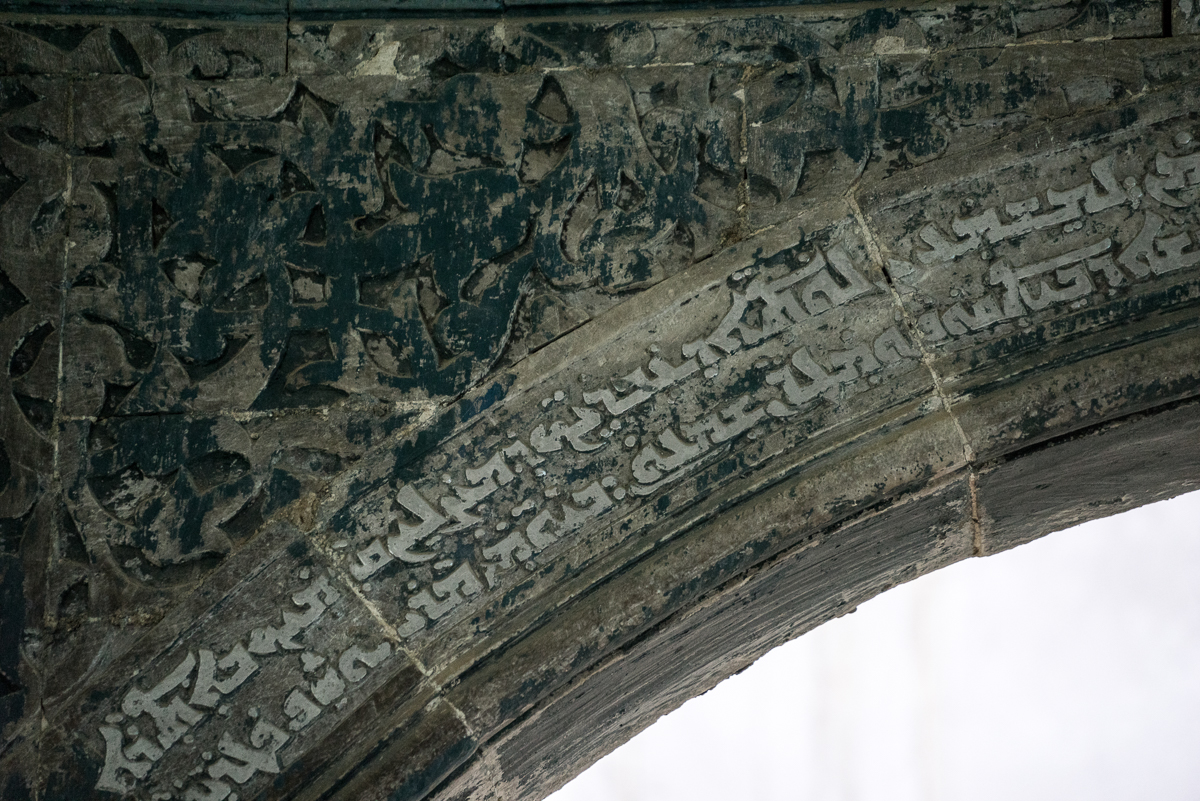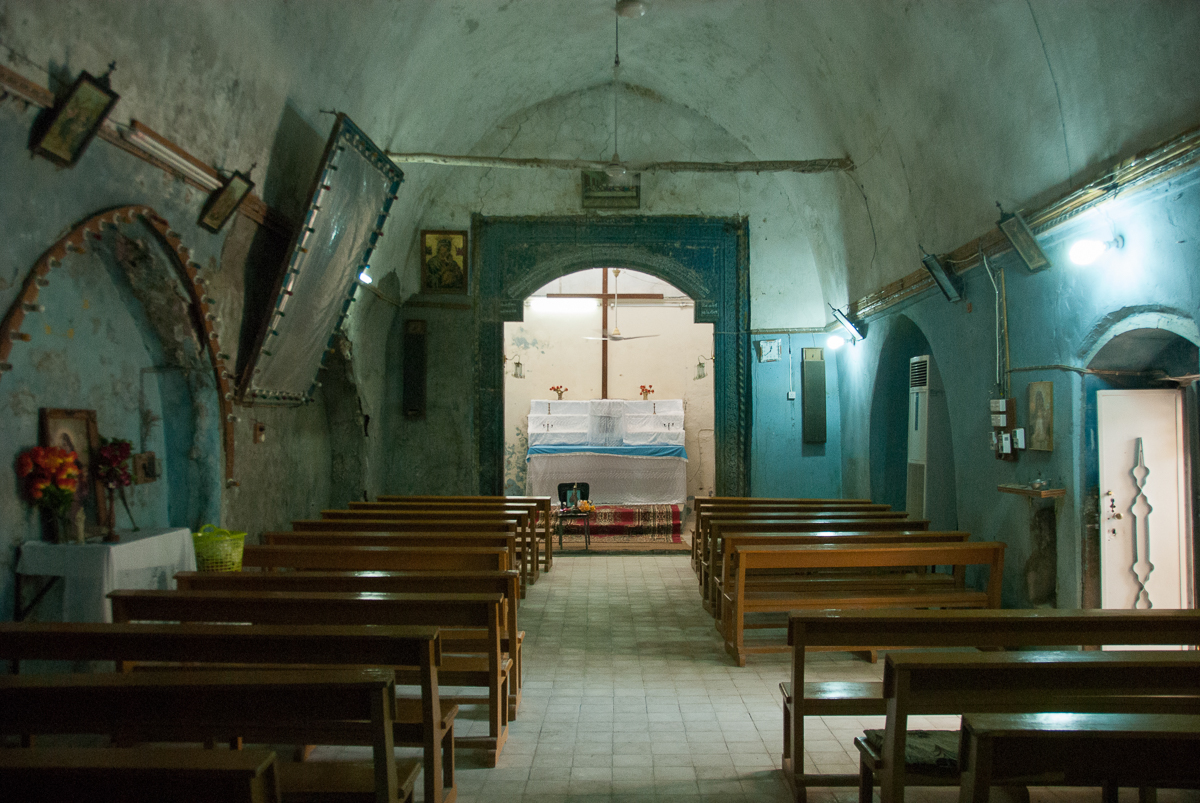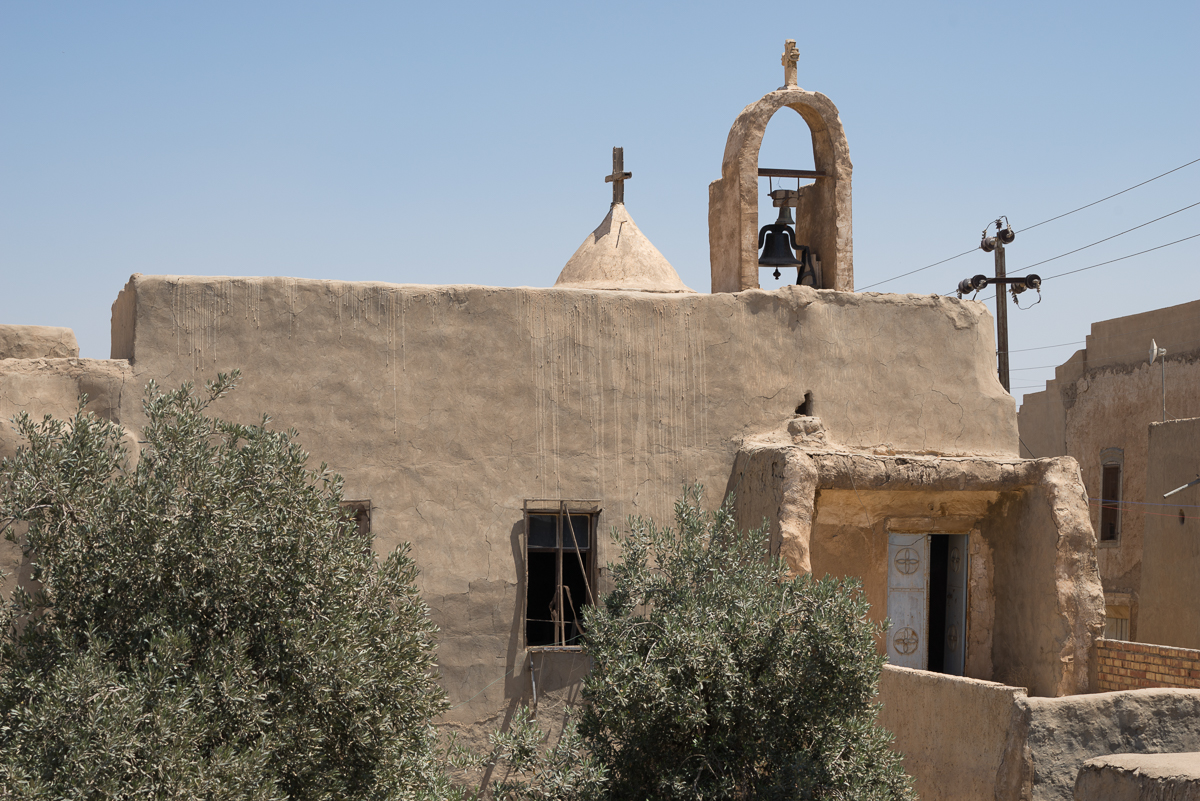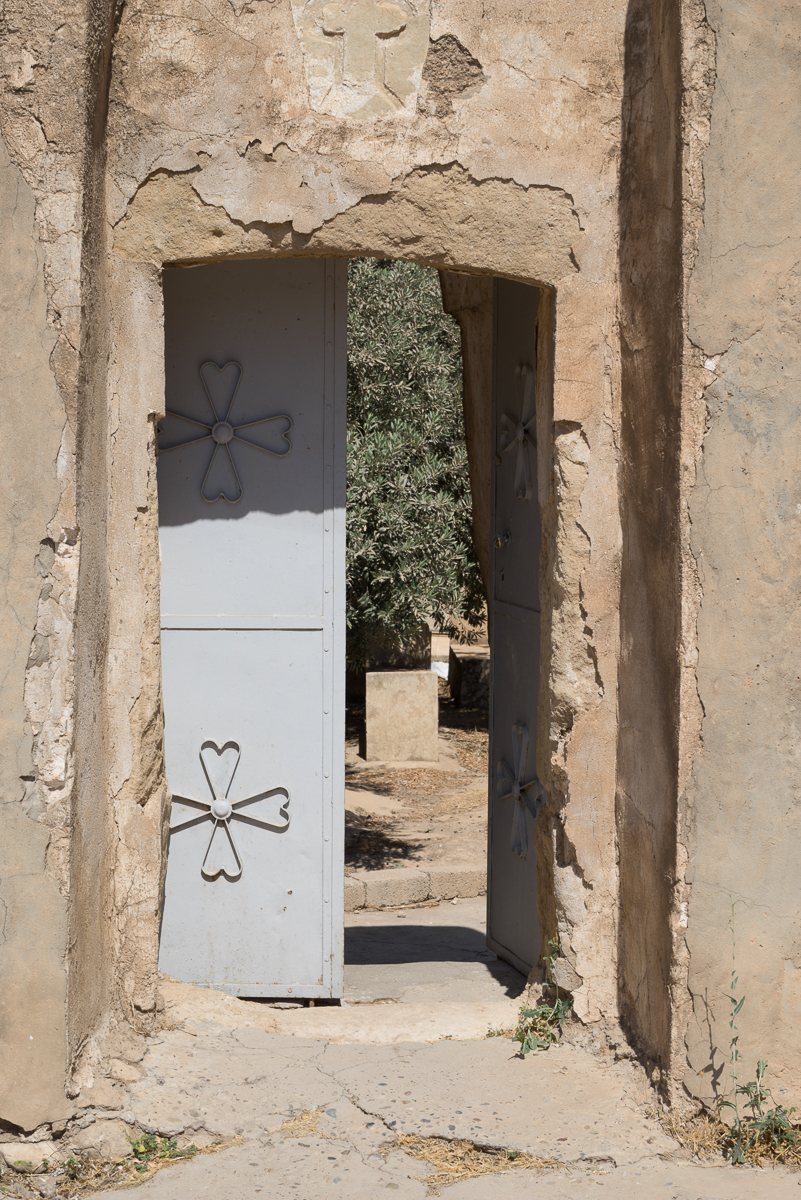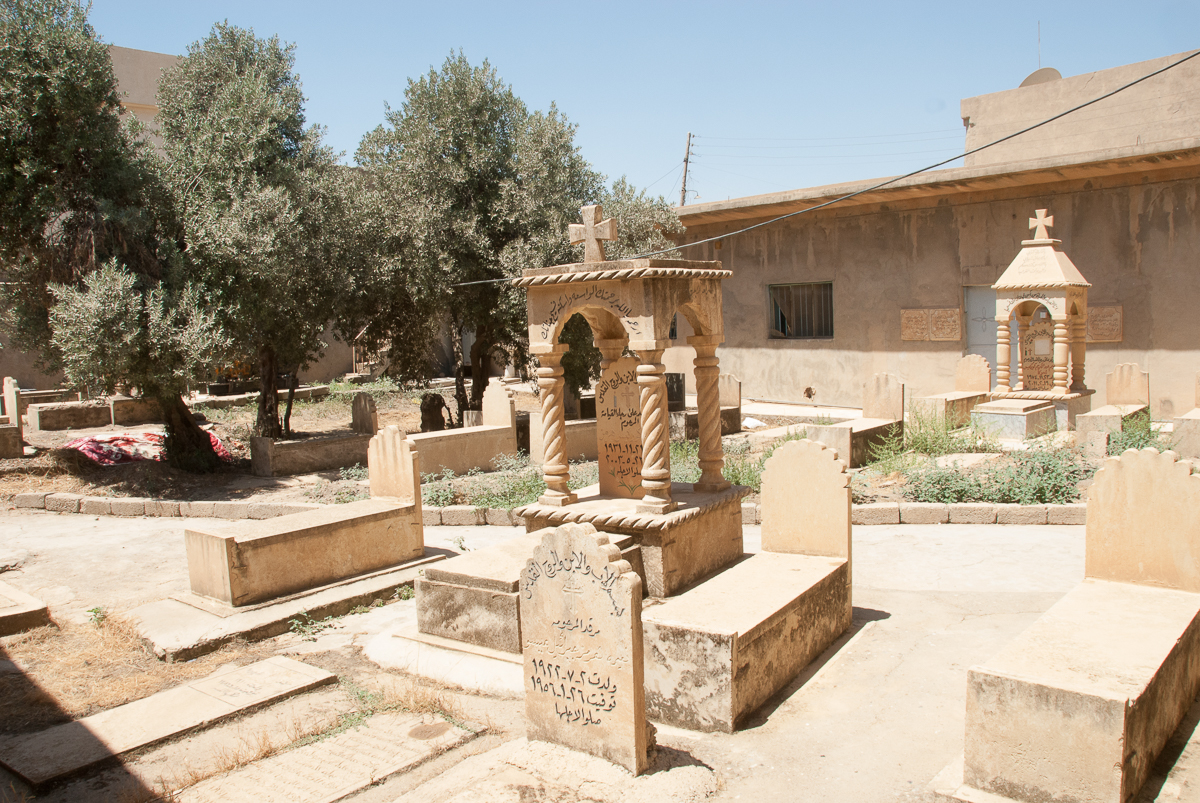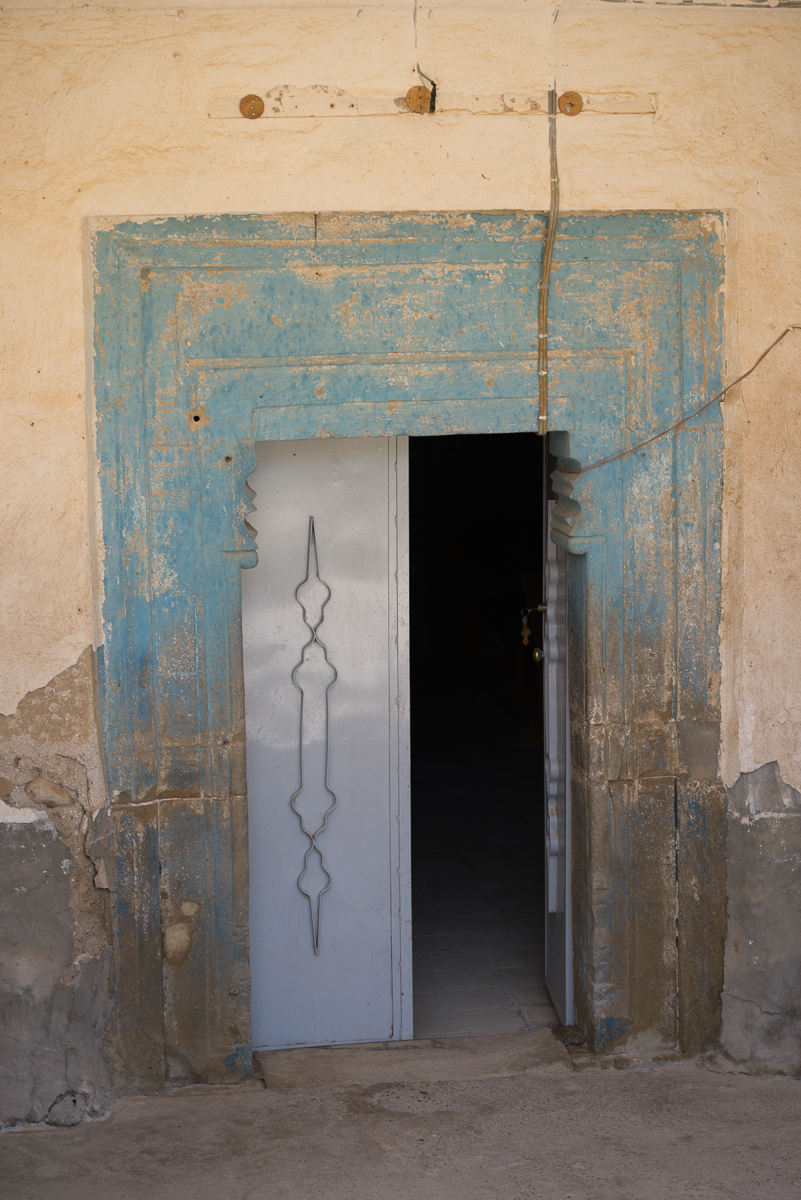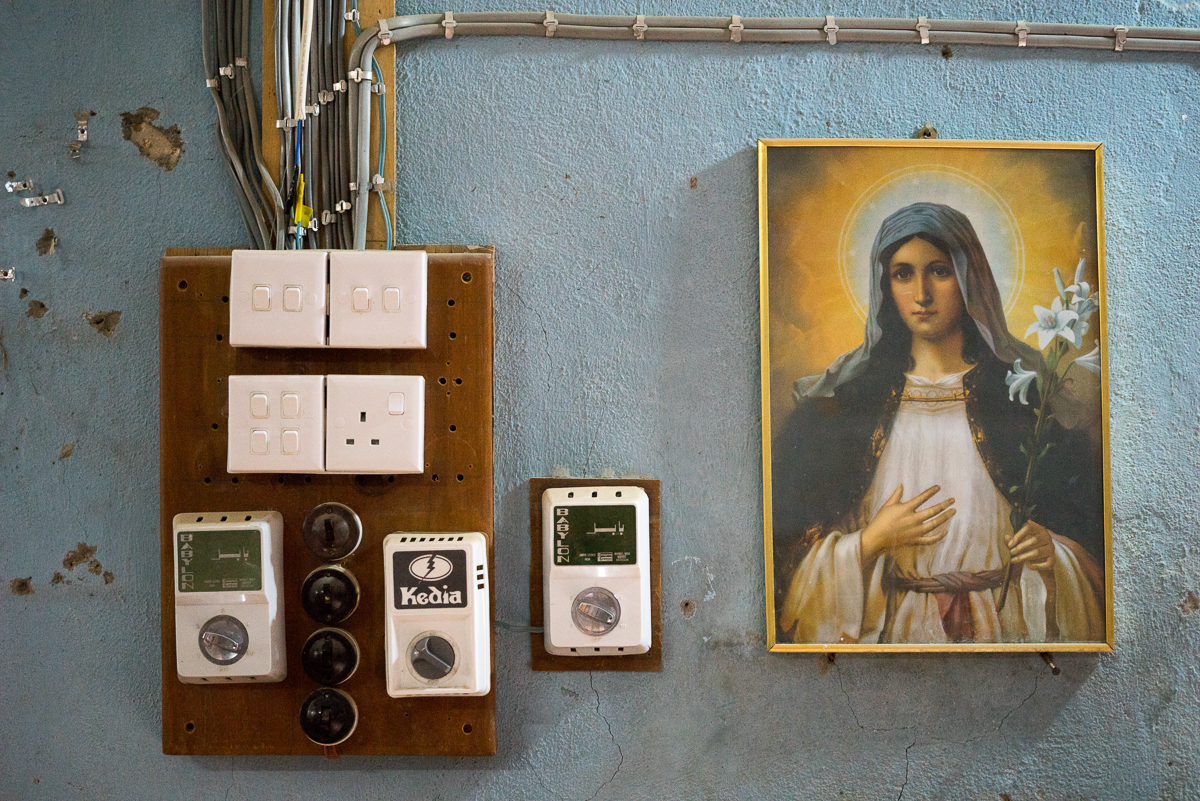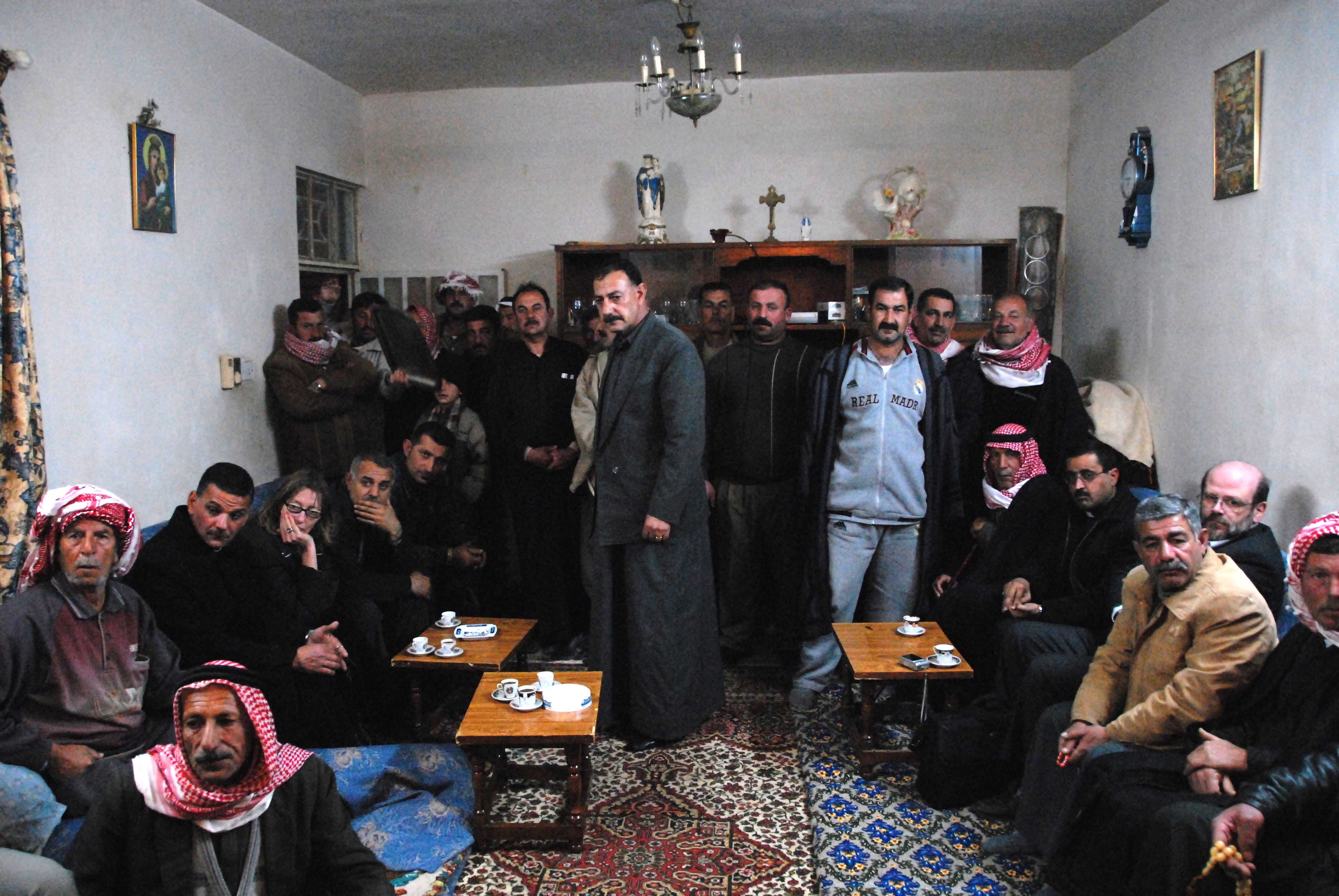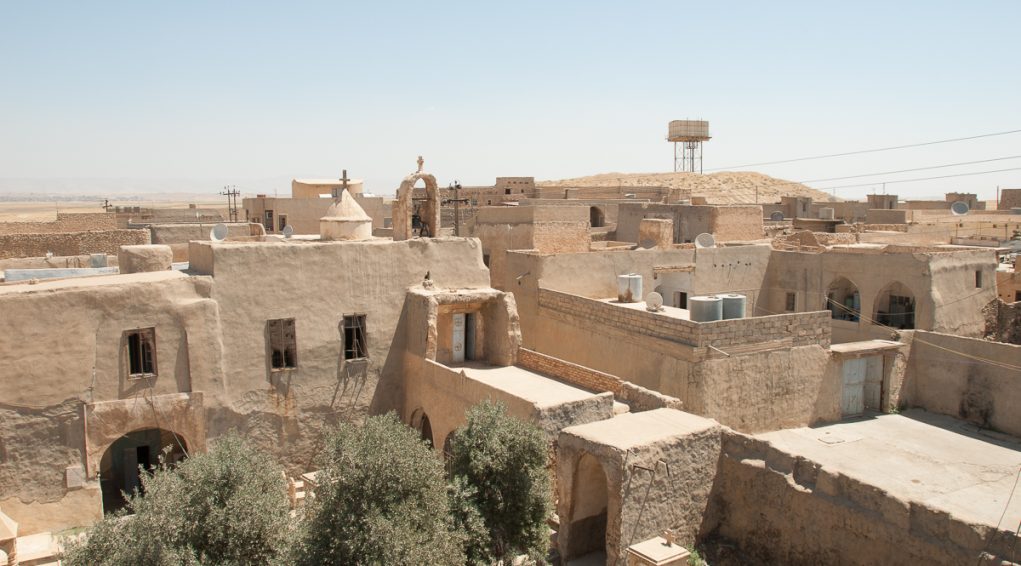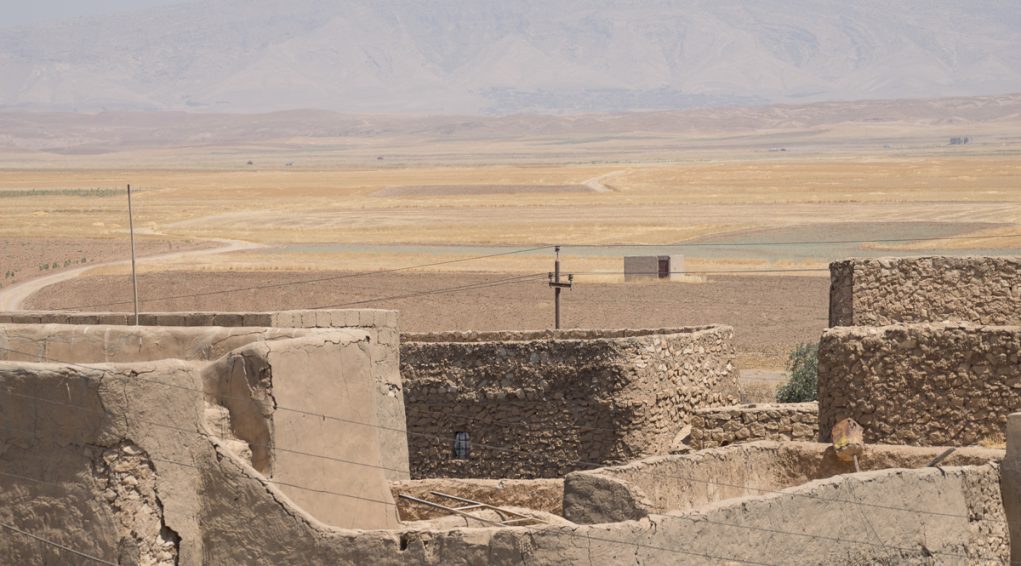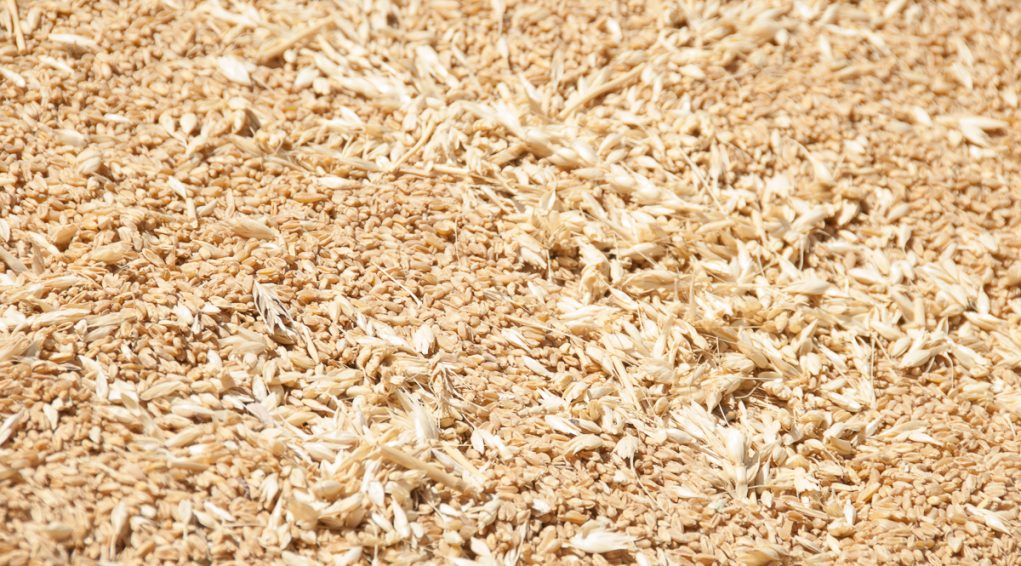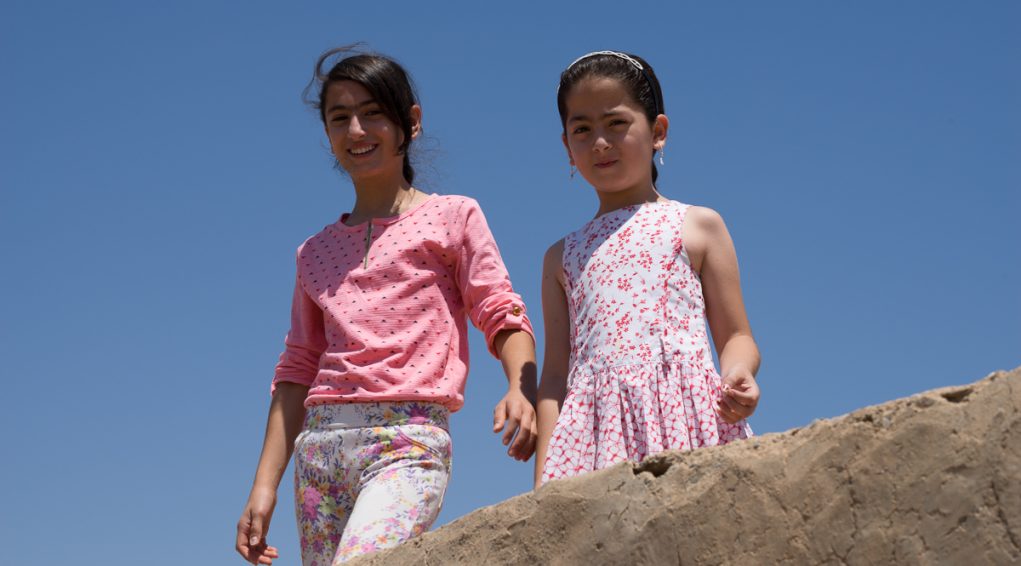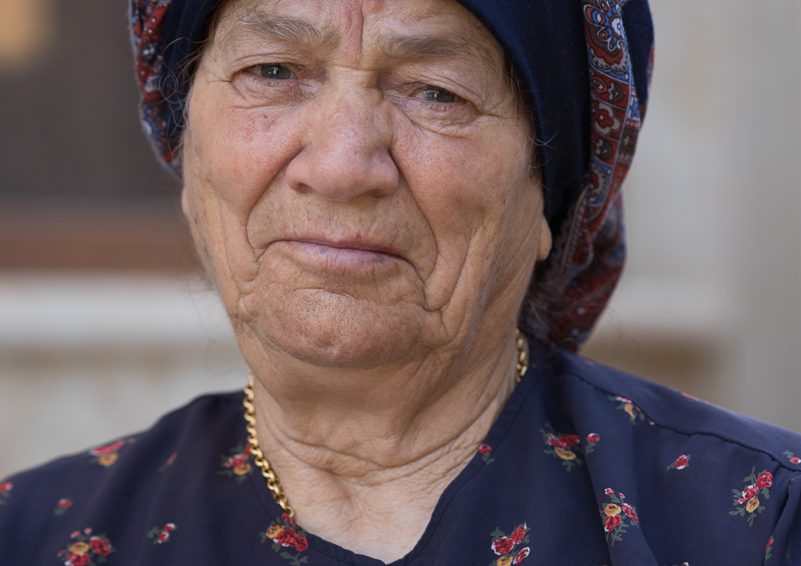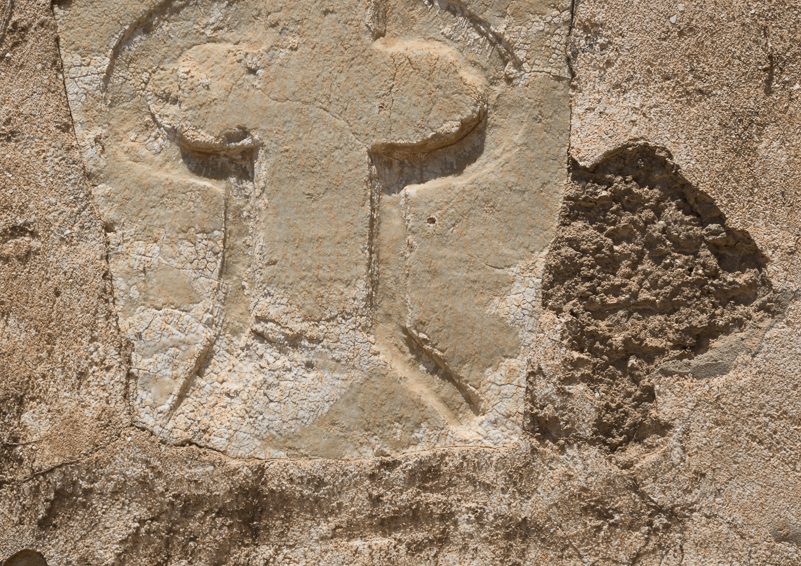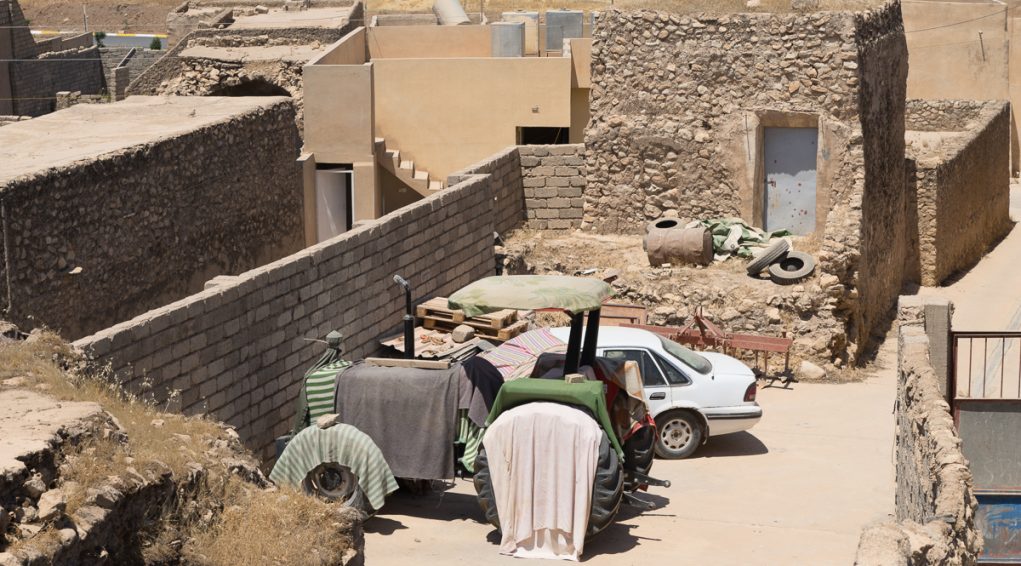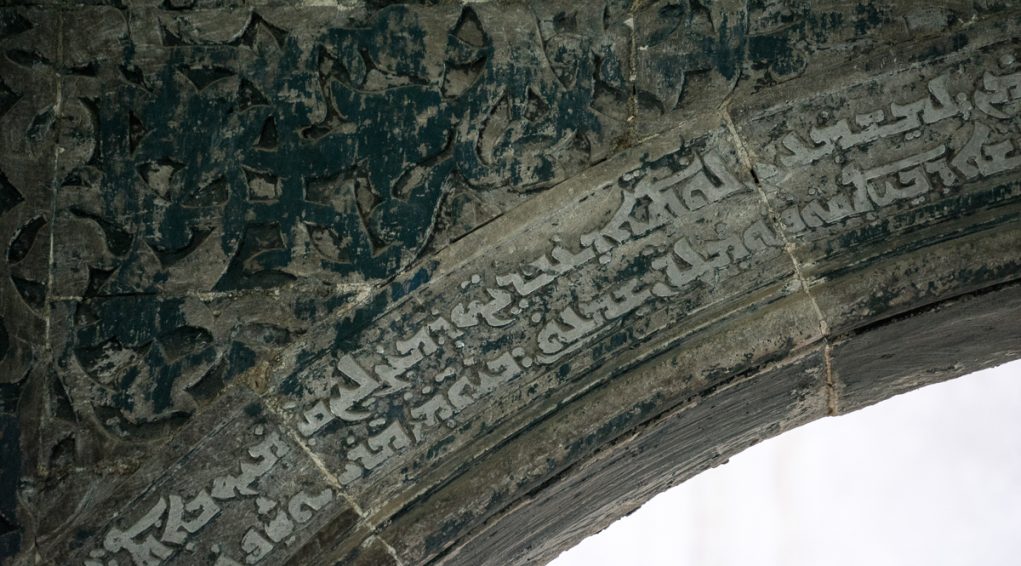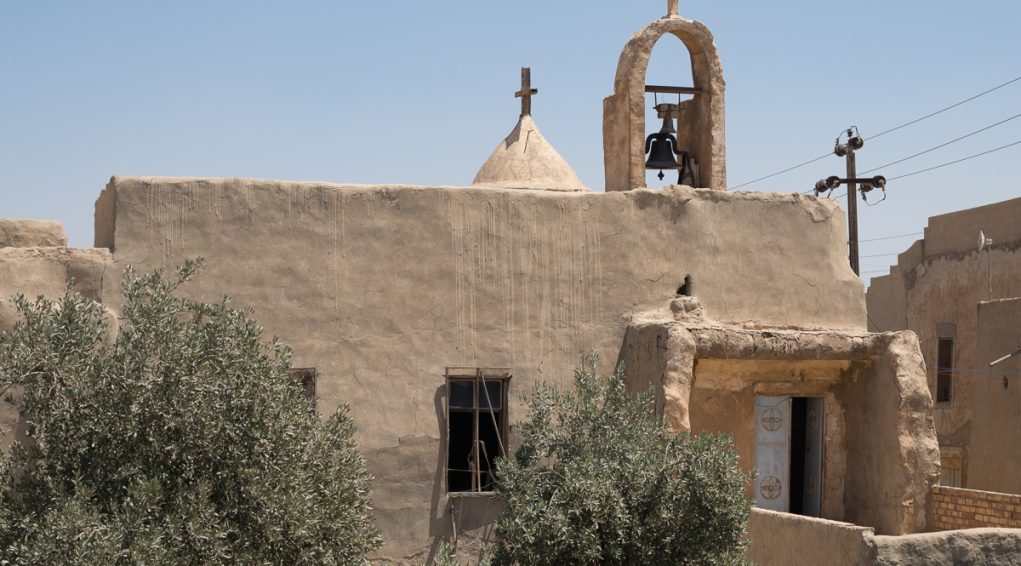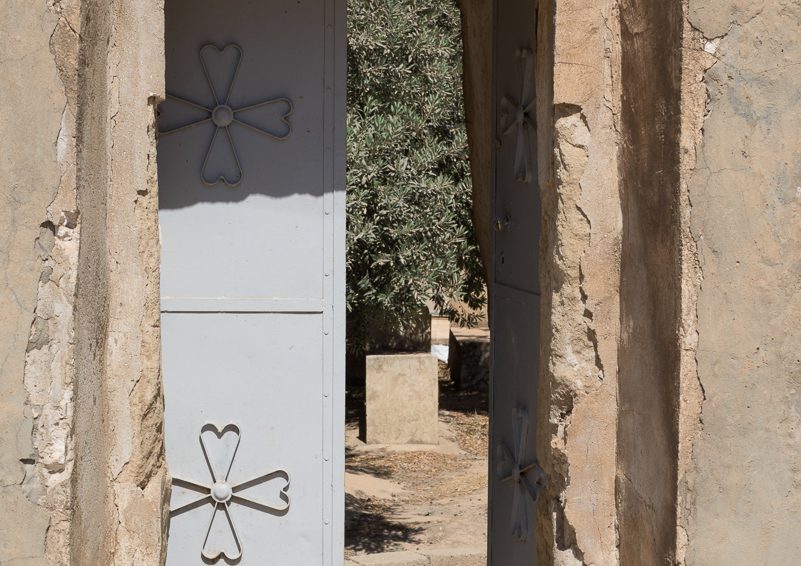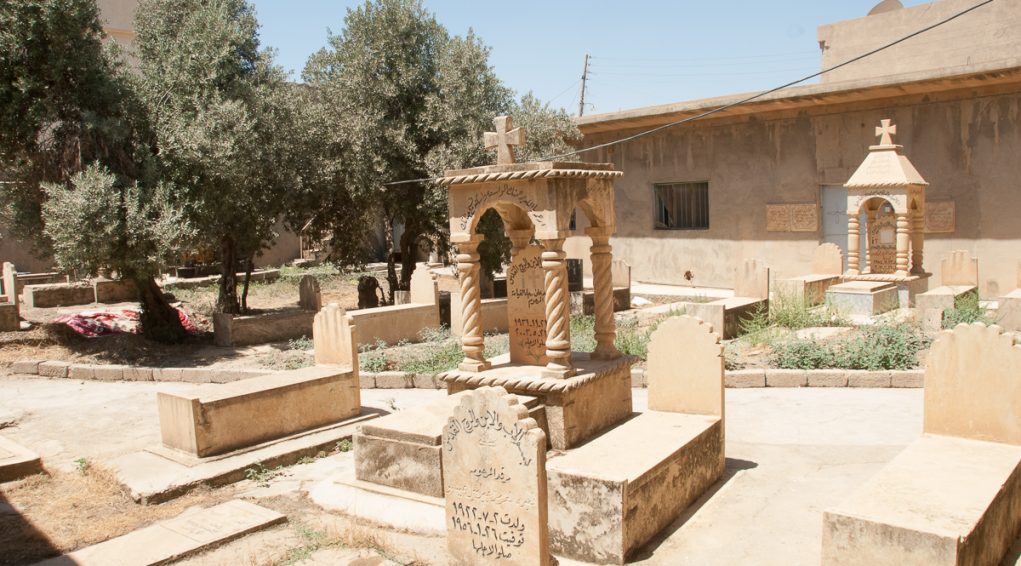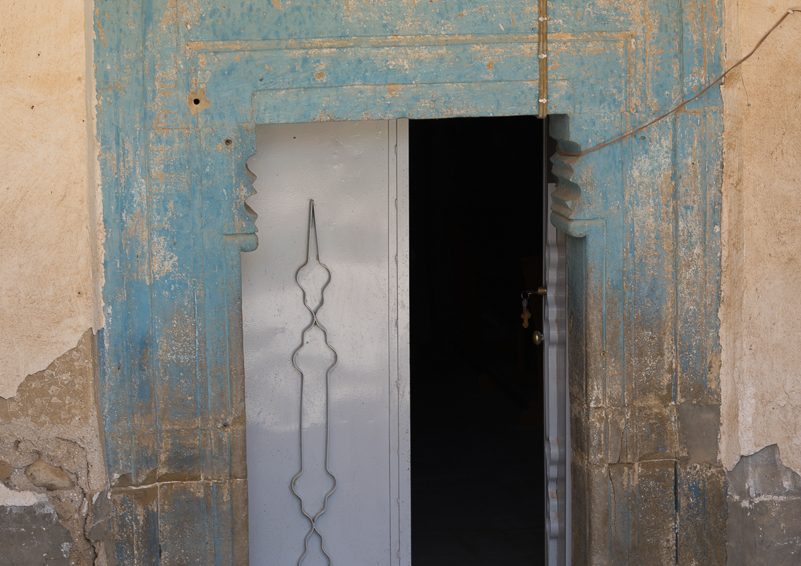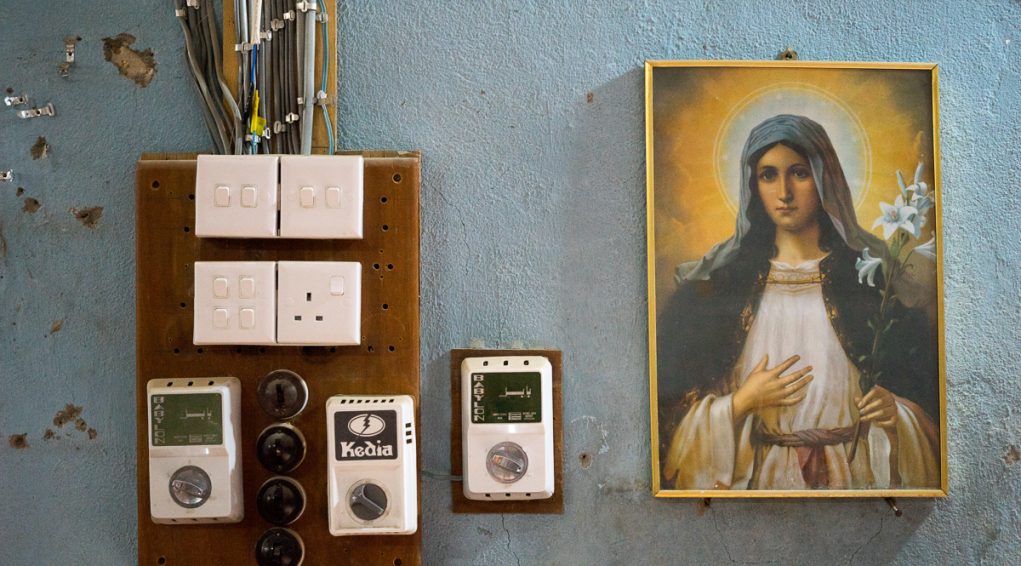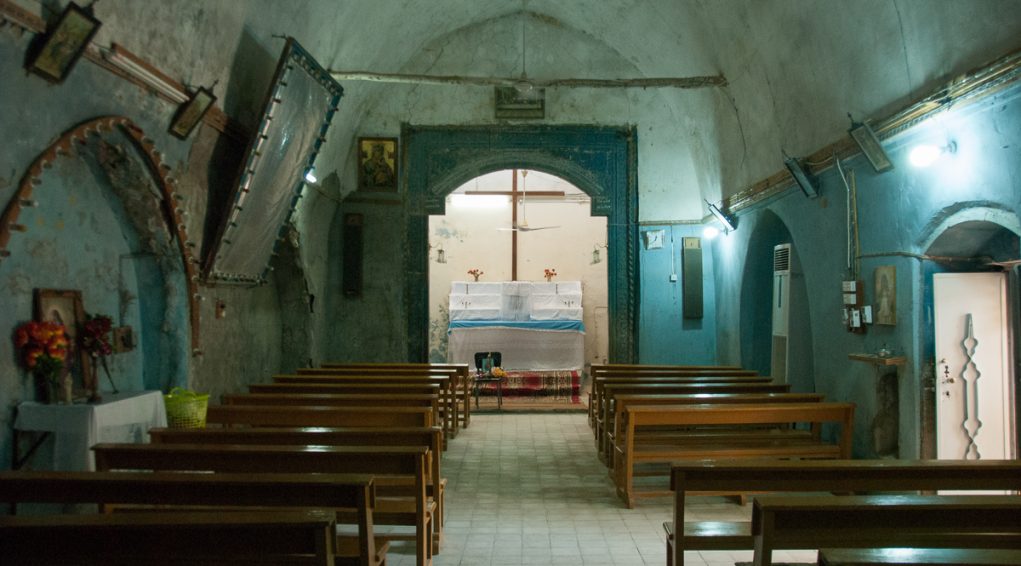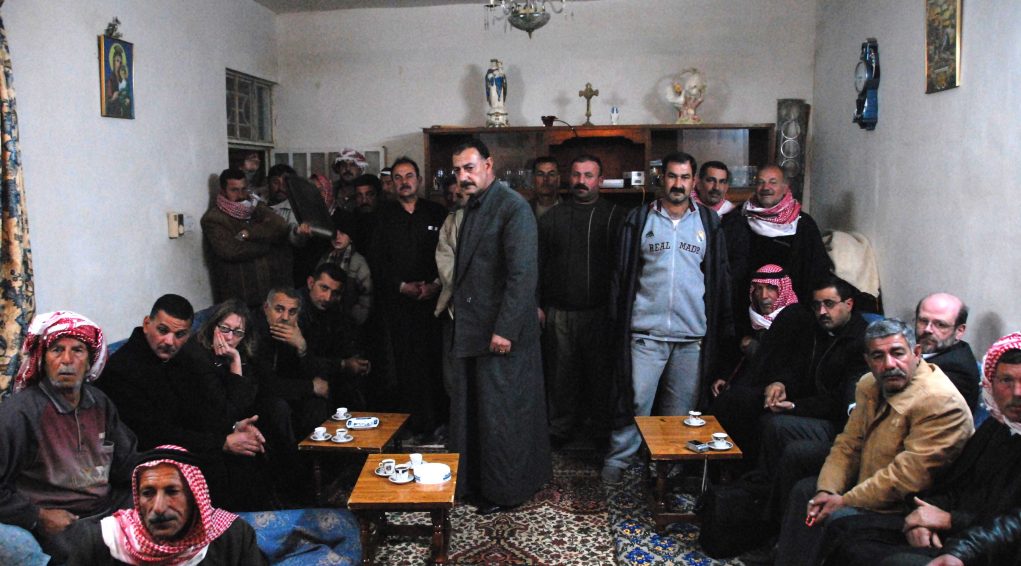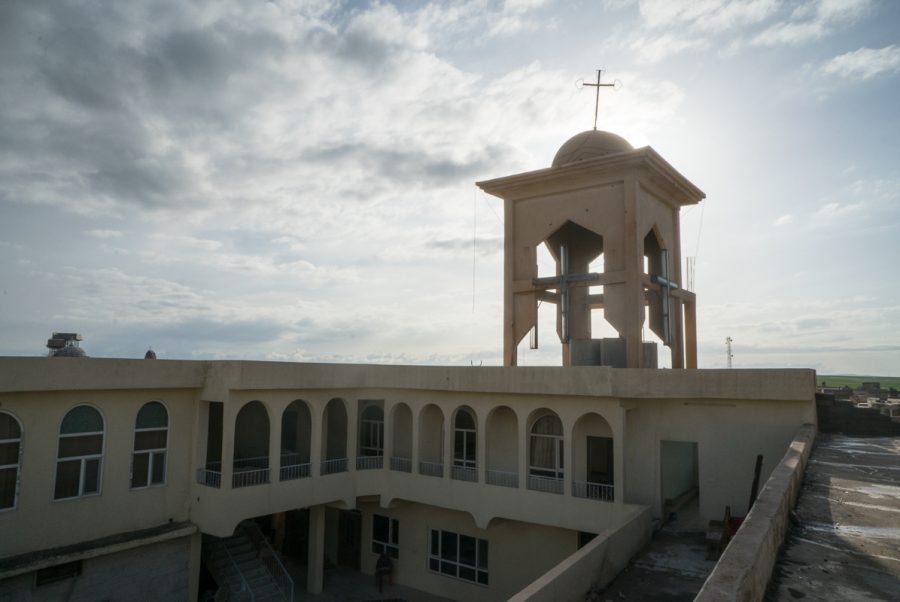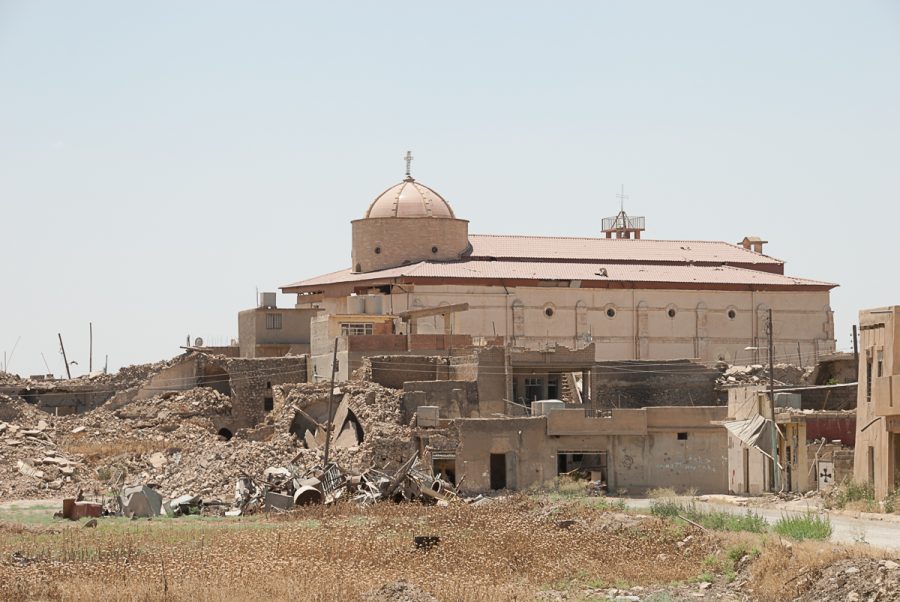The Mar Gorgis Church in Baqofa
The Mar Gorgis church in Baqofa is located at 36°35’20.00″N 43°7’50.40″E and 335 metres altitude. Baqofa is a very ancient Chaldean village.
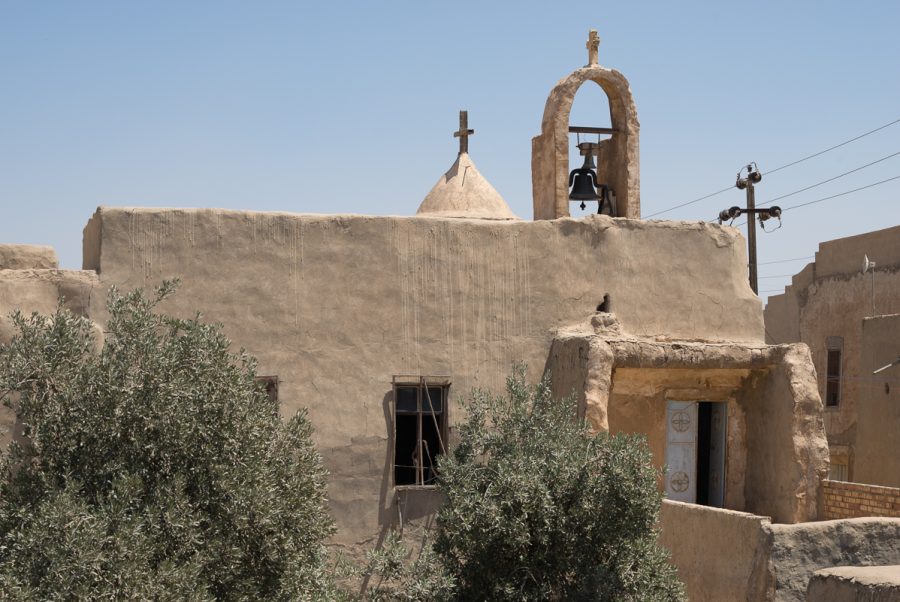
Baqofa is cited in the first half of the 7th century for its contribution to building the monastery of Rabban Hormizd.
The Mar Gorgis church in Baqofa is a rustic building, built using rough-hewn quarry stones covered with a smooth coating. It is built in an enclosed space with perimeter walls 3 to 4 metres high. The cemetery which occupies the small internal courtyard must first be crossed before accessing the church itself.
The church is a single nave building with a pointed arch vault. The royal door of the sanctuary is made of finely crafted cut stone, adorned with decorative friezes and Syriac inscriptions on the upper arch attesting to its restoration in 1868.
The Mar Gorgis Church in Baqofa. June 2017 © Pascal Maguesyan / MESOPOTAMIA
Location
The Mar Gorgis church in Baqofa is located at 36°35’20.00″N 43°7’50.40″E and 335 metres altitude.
Baqofa is situated on the eastern bank of the Tigris river, 30 km to the north of the centre of Mosul, 12 km to the north of Tell Kaif (Tell Kepe), 5 km north of Batnaya and 2 km south-east of Tell Esqof (Telskuf) .
Cuneiform inscriptions have been found in this ancient Assyrian village, which has preserved its traditional character. Its ancient origins explain why the village was partially built on a promontory. It is composed of a double archaeological tell, one of which is partly occupied by the village cemetery.
Toponymy, economy
Demography of Baqofa
Baqofa is an exclusively Chaldean village. Like many of the towns and villages in this region, the inhabitants of Baqofa left the Holy Apostolic Catholic Assyrian Church of the East (also known as the Church of Persia or the Nestorian Church) for the Chaldean Church (in communion with Rome) in the 18th century.
In 185O, George Percy Badger[1]reported 20 families in the village. In 1923, Monsignor Sayegh counted 490 villagers. In 1961, there were “70 to 80 families” or 400 people[2]. In 2014, before the ISIS offensive, the village was home to 91 families[3], a total of around 600 inhabitants. During its occupation, the inhabitants of Baqofa were forced to flee to Iraqi Kurdistan.
[1]See G.P.Badger “The Nestorians and their rituals”, London, Joseph Masters, II. P.174
[2]Source Jean-Maurice Fiey, in “Assyrie Chrétienne”, vo.II, p. 380.
[3]Source Niniveh Reconstruction Committee: https://www.nrciraq.org/reconstruction-process/baqofa-restoration-process-and-returnees/
Fragments of Christian history
According to the tradition, Christianity entered the Nineveh plain at the end of the 4th century or the beginning of the 5th century. More surely, sources speak of evangelization during the 7th century. It was the monk Abraham (Awrāha / Oraha), a contemporary of the patriarch of the Church of the East Ishoʿyahb II (628-645) who was accredited with spreading the faith in the villages in the region. His abandoned monastery is located just a few kilometres from BAqofa, 1 km north-east of Batnaya.
Baqofa is also cited in the first half of the 7th century for its contribution to building the monastery of Rabban Hormizd (see notice). [1]
Throughout the centuries, the Christian cities of Mesopotamia have suffered from all types of destruction. In 1235, Bar Hebraeus, a Maphrian Syriac-Orthodox scholar and writer, recounts the onslaught and destruction of the Mongols. In 1743 the Persian emperor Nader Shah attacked, plundered and ruined the village, as he had done throughout the region. We also know that there was more than one outbreak of the plague in Mosul and the Nineveh plain, notably in 1737/38, 1773, then 1828.
The monastery Our Lady of the Seeds (see notice) owns a manuscript of a 19th century religious scribe from Baqofa, Stéphane Marrōgue[2]. Father Jacques-Eugene Manna[3], author of the work “Chaldean Arabic Vocabulary” in 1900, was born in Baqofa in 1867.[4]
_______
[1]Source Jean-Maurice Fiey, in “Assyrie Chrétienne”, vo.II, p. 380 and E. A. Wallis Budge “Histories of R. Hormizd the Persian”, 1902
[2]Source Jean-Maurice Fiey, in “Assyrie Chrétienne”, vo.II, p. 380.
[3]Jacques-Eugene Mannasubsequently became bishop of Tabbora and patriarchal vicar of Basra. He died in 1928 and his grave is located at the seat of the Chaldean archdiocese in Mosul.
[4]Vocabulaire chaldéen-arabe, Imprimerie des Pères Dominicains, Mossoul, 1900.
The recent history of Baqofa: 2014-2017
The inhabitants of Baqofa were forced to abandon their homes and flee to Iraqi Kurdistan when ISIS advanced into the Nineveh plain at the start of August 2014. Around one hundred houses in Baqofa were ransacked and five destroyed. Since the defeat of ISIS and the liberation of the village, the villagers have gradually returned home.
However, on 24 October 2017, the population of Baqofa fled the village again due to skirmishes between the Kurdish Peshmerga and government forces due to tensions arising from the independence referendum for Iraqi Kurdistan. Baqofa (and Tell Esqof) are located in a “grey” zone controlled de facto by Iraqi Kurdistan but over which the government in Baghdad has reasserted its administrative authority.
History of the Mar Gorgis church in Baqofa
The date the Mar Gorgis church in Baqofa was founded is unknown. However, the village converted to Christianity in the 7th century which suggests that there has always been a church there.
The Mar Gorgis church certainly has all the characteristics of an ancient church, no doubt regularly renovated, restored, possibly even rebuilt, in particular in October 1868, then at the end of the 1950s or the start of the 1960s.[1]
_______
[1]Source Jean-Maurice Fiey, in “Assyrie Chrétienne”, vo.II, p. 380.
Description of the Mar Gorgis church in Tell Baqofa
The Mar Gorgis church in Baqofa is a rustic building, built using rough-hewn quarry stones covered with a smooth coating. The roof terrace is mounted with a small bell and a conical dome on a windowless drum above the sanctuary.
The Mar Gorgis church is located in a closed off space with a 3 to 4 metre’ high perimeter wall, perforated with two metallic entrance doors with porches. The cemetery which occupies the small internal courtyard must first be crossed before accessing the church itself.
The church is accessed via a soberly decorated door and no visible inscriptions. The church, plunged into semi-obscurity, is a single nave building with a pointed arch vault. The royal door of the sanctuary is made of finely crafted cut stone, adorned with decorative friezes and Syriac inscriptions on the upper arch attesting to its restoration in 1868. The sanctuary has an altar with steps, built up against the apse.
The interior walls, including the royal door, were painted blue.
One of the most ancient Syriac inscriptions identified dates back to 1565.[1]
There is a chapel dedicated to Mart Shmoni in the ancient cemetery of the village.
_______
[1] Source http://www.chaldeansonline.org/village/baqofa.html
Memories of a survivor from Baqofa
Since the fall of Saddam Hussein’s regime in 2003 and the emergence of a number of Islamist and organised crime groups, many Iraqi Christians have been kidnapped, in regions and towns throughout the country: Baghdad, Mosul, Nineveh plain … “Blackmail, political and religious rivalries, Islamic fundamentalism, greed. Christians live in fear of these practices. The kidnappings of members of the clergy and consecrated men and women are intended to intimidate the fragile Christian community. The kidnappings and disappearances of young Christian women have scared them into fleeing and leaving everything behind them. Other kidnappings have targeted members of wealthy Christian families. In all cases, the ransoms have to be paid or the victim will be killed.[1]” On 14 February 2008, the Pax Christi delegation led by Monsignor Marc Stenger visited Baqofa and met a hostage who had been released the very same day. “An unsuspecting hero, the farmer had been kidnapped from his field just a week earlier. The cost of his life: $60,000 (€40,000): As Christians we are under threat. I was kidnapped on my way home from work. There were three of them, heavily armed, with two machine guns and a revolver. They were masked. I was taken hostage for a week. It didn’t go well with the hostage takers. There was no communication with my family. They took away more than just our strength and our ability. They took away years and years of work and the rest had to be borrowed to free me. Who were the kidnappers?No-one knows, but everyone knows that Christians are peace-loving.Easy prey.”[2]
_______
[1]In “Chrétiens d’Orient, ombres et lumières” by Pascal Maguesyan. Thadée, October 2013.
Monument's gallery
Monuments
Nearby
Help us preserve the monuments' memory
Family pictures, videos, records, share your documents to make the site live!
I contribute
